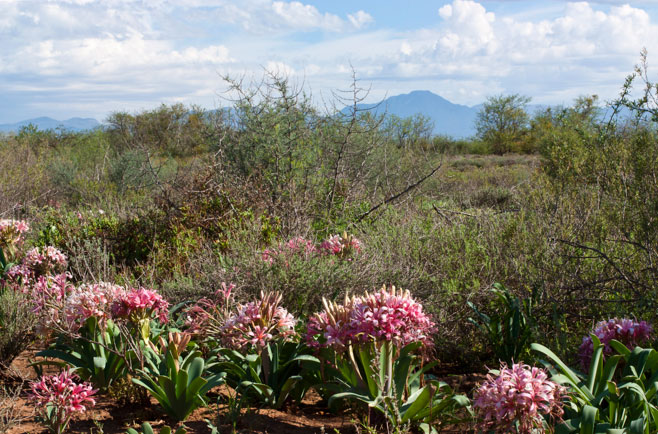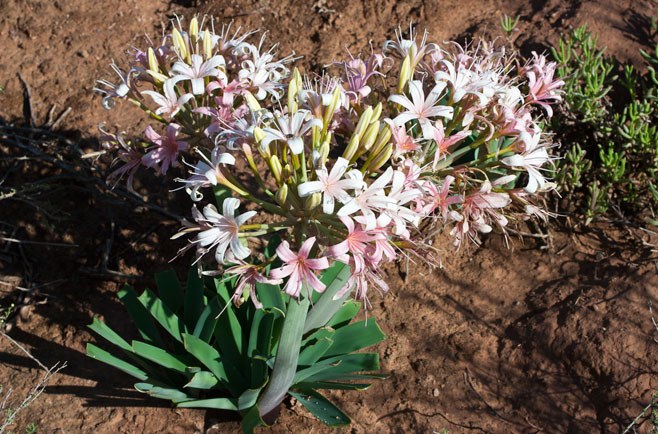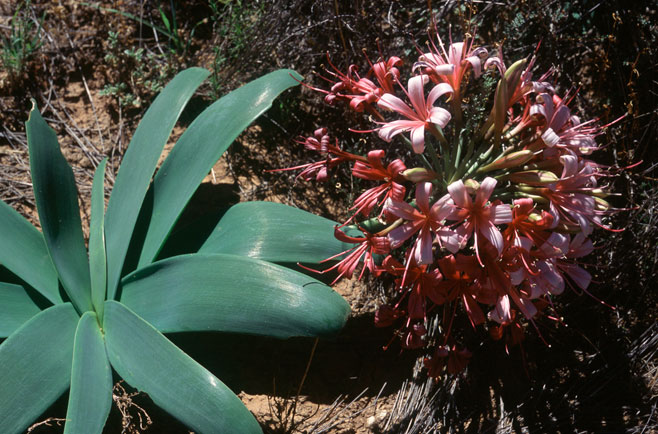Ammocharis coranica (Ammocharis,
Ground lily)
Berglelie, Gifbol, Seeroogblom [Afrikaans]; boka [South
Sotho]; icukudo, incukudwane, isidiya, umbhodiya [Zulu]
Life
> eukaryotes >
Archaeoplastida >
Chloroplastida
>
Charophyta > Streptophytina > Plantae (land plants)
> Tracheophyta (vascular plants) > Euphyllophyta > Lignophyta (woody plants)
> Spermatophyta (seed plants) > Angiospermae (flowering
plants)
> Monocotyledons > Order: Asparagales
> Family: Amaryllidaceae > Ammocharis
 |
|
Ammocharis coranica flowering in summer in
the Little Karoo west of De Rust, Western Cape, South Africa. [photo
Colin Paterson-Jones ©] |
 |
|
Ammocharis coranica flowering in summer in the
Little Karoo west of De Rust, Western Cape, South Africa. [photo
Colin Paterson-Jones ©] |
 |
| Ammocharis coranica flowering in summer in
the Great Karoo near Beaufort West, Western Cape, South Africa. [photo
Colin Paterson-Jones ©] |
Distribution and habitat
Widespread in southern Africa, from Oudtshoorn
to southern Angola and Zimbabwe. Occurs on seasonally damp flats.
Life cycle
Flowers in summer, from November to February.
Ecological interactions
Herbivores
- According to Pooley (1998) leaves are heavily browsed by
stock but according to Shearing and van Heerden (1994), the
whole plant and bulb are very poisonous to all livestock and are
not grazed.
Chemistry
Bulbs have been recorded with the following
substances:
-
acetylcaranine (Hutchings et al.
1996; Koorbanally et al. 2000)
-
1-O-acetyl-9-O-demethylpluviine
(Koorbanally et al. 2000)
-
caranine (Hutchings et al. 1996)
-
crinamine (Hutchings et al. 1996;
Koorbanally et al. 2000)
-
lycorine
(Hutchings et al. 1996; Koorbanally et al. 2000)
-
1-O-acetyllycorine (Koorbanally et al.
2000)
-
haemolytic saponin (Hutchings et al.
1996)
-
hamayne (Koorbanally et al. 2000)
-
hippadine (Koorbanally et al. 2000)
-
6α-hydroxypowelline (Koorbanally et al.
2000)
-
ambelline (Hutchings et al. 1996)
-
buphanidrine (Hutchings et al. 1996)
-
buphanisine (Hutchings et al. 1996)
-
cycloartane compounds
-
24-methylenecycloartan-3β-ol (Koorbanally
et al. 2000)
-
cycloeucalenol (Koorbanally et al.
2000)
-
cycloeucalenone (Koorbanally et al.
2000)
-
24-methylenepollinastanone (Koorbanally
et al. 2000)
Uses
- Bulbs are used in Zulu herbal medicine for treating serious
afflictions considered to be the result of witchcraft (Hutchings
et al. 1996).
- Unspecified parts of the plant are used in Zulu herbal
medicine for treating cattle (Hutchings et al. 1996).
- In Lesotho, the bulb is ground into a paste that is used to waterproof
pots (Watt and Breyer-Brandwijk 1962).
Links
Publications
- Hutchings, A., Scott, A.H., Lewis, G. and Cunningham, A.
1996. Zulu Medicinal Plants - an Inventory. University of
Natal Press, Pietermaritzburg.
- Koorbanally N., Mulholland D.A., Crouch N. 2000. Alkaloids
and triterpenoids from Ammocharis coranica
(Amaryllidaceae). Phytochemistry 54(1): 93-97.
doi:10.1016/S0031-9422(00)00039-X
- Pooley, E. 1998. A Field Guide to
Wild Flowers KwaZulu-Natal and the Eastern Region. Natal Flora
Publications Trust, Durban, p. 350.
- Shearing, D. & van Heerden, K. 1994.
Karoo. South African Wild Flower Guide 6. Botanical Society of Southern
Africa, Kirstenbosch.
-
Watt, J.M. and Breyer-Brandwijk, M.G. 1962. The Medicinal and Poisonous
Plants of Southern and Eastern Africa. Second Edition. E. & S. Livingstone
Ltd., Edinburgh.
Text by Hamish Robertson |
